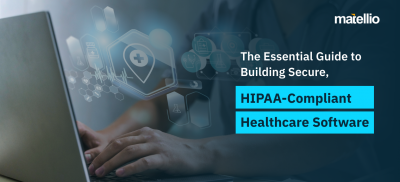
The landscape of healthcare is undergoing a remarkable transformation powered by groundbreaking advancements in medical technology. At the forefront of this revolution lies medical device software development, playing a critical role in the evolution of lifesaving and life-enhancing devices.
Medical device software is crucial in enhancing patient care and revolutionizing healthcare practices, from diagnostic tools to treatment solutions. In this blog, we will explore the development process, discover key technologies and trends, and showcase how medical device software is transforming the healthcare landscape. Let’s embark on this journey together as we discover the power of software in shaping the future of healthcare.
So, buckle up and join us as we embark on a journey into the heart of innovation, where software beats alongside the pulse of medical devices, driving the future of healthcare toward a brighter and healthier tomorrow.
Features of Medical Device Software
Whether it’s a software component embedded in a medical device, or a standalone application used to control or interact with devices, certain features are essential for ensuring functionality, safety, and compliance with regulations. Here are some key features commonly found in medical device integration software:
 Data Management
Data Management
Medical device software manages patient data, including medical history, test results, and treatment plans. It ensures the secure storage and retrieval of patient data, allowing healthcare providers to make informed decisions.
 Remote Monitoring
Remote Monitoring
Medical devices software allows remote monitoring of patient’s vital signs and health metrics. This feature is useful for patients with chronic conditions requiring continuous monitoring.
 Alerts and Notifications
Alerts and Notifications
Medical device software can generate alerts and notifications for healthcare providers based on predefined criteria. This helps in the timely intervention and management of patient care.
 Compatibility
Compatibility
Compatibility is a key feature of medical device software, allowing it to integrate with other healthcare systems and devices. This enables seamless data exchange and coordination of care across different healthcare settings.
 Decision Support
Decision Support
Medical device software provides decision support tools to healthcare providers, helping them make evidence-based decisions. This includes access to clinical guidelines, drug interaction databases, and diagnostic algorithms.
 Safety and Security
Safety and Security
Medical devices software ensures the safety and security of patient data through encryption, access controls, and regular security audits. It complies with regulations such as HIPAA to protect patient privacy.
 User Interface
User Interface
A user-friendly interface is essential for medical device software, allowing healthcare providers to navigate the system and access patient information easily. Intuitive interfaces improve efficiency and user satisfaction.
 Regulatory Compliance:
Regulatory Compliance:
Medical device software complies with regulatory standards such as the FDA’s Quality System Regulation (QSR) and the International Electrotechnical Commission (IEC) 62304 standard for medical device software.
 Scalability and Flexibility
Scalability and Flexibility
Medical devices software is crafted to be scalable and flexible, enabling it to adapt to the changing needs of healthcare organizations. It can accommodate growth in patient volume and new technologies.
 Integration with Electronic Health Records (EHR)
Integration with Electronic Health Records (EHR)
Integration with EHR systems enables medical device software to access and update patient records seamlessly. This improves care coordination and reduces duplication of data entry.
Medical device software plays a critical role in improving the functionality and usability of medical devices, enabling healthcare providers to deliver good care and improve patient outcomes. Hire a professional healthcare software development company to incorporate these essential features in medical device software to meet the complex requirements of the healthcare industry while ensuring safety, security, and compliance with regulatory standards.
Also Read: Medical Practice Management Software Development: Navigating Solutions
Use Cases of Medical Device Software
Let’s explore some key use cases where medical device software is making a significant impact:
Remote Patient Monitoring
Medical device integration software enables remote monitoring of patients’ vital signs and medical data, enabling healthcare providers to track patient health in real time and intervene when necessary. This is specifically beneficial for patients with chronic conditions who require continuous monitoring.
Diagnostic Imaging
Medical imaging software enhances diagnostic capabilities by enabling healthcare providers to observe and analyze medical images such as X-rays, CT scans, and MRIs. This software can help in the early detection and diagnosis of various medical conditions.
Electronic Health Records Management
EHR software streamlines the management of patient health records, enabling healthcare providers to access and update patient data securely. This enhances communication between healthcare providers and patient care.
Read More: Enhance patient care and streamline operations with a leading EHR software development company.
Telemedicine and Telehealth
Medical device integration software supports telemedicine and telehealth services, enabling healthcare providers to deliver remote healthcare services to patients. This includes virtual consultations, remote monitoring, and telemedicine-enabled devices.
Surgical Planning and Navigation
Medical Device Software helps surgeons plan complex procedures by creating 3D models of patient anatomy and simulating surgical outcomes. Surgical navigation software assists surgeons during procedures by providing real-time guidance and feedback.
Medication Management
Medical device integration software helps healthcare providers prescribe and manage medications for patients, including dosage information, drug interactions, and patient compliance tracking. This software can improve medication safety and adherence.
Clinical Decision Support
Medical device software provides healthcare providers with evidence-based recommendations and alerts to support clinical decision-making. This can assist in enhancing patient outcomes and reducing medical errors.
Also Read: How to Develop a Medical Journal App?
Wearable Health Devices
Medical device software powers wearable health devices such as smartwatches and fitness trackers, which monitor health metrics such as heartbeat, activity levels, and sleep patterns. These devices can assist users in tracking their health and fitness goals.
Rehabilitation and Physical Therapy
For rehabilitation and physical therapy, medical device integration software provides exercises and therapy programs tailored to individual patient needs. The software can help patients recover from injuries and surgeries more effectively.
Medical Research and Clinical Trials
Medical device software is used in medical research and clinical trials to collect, analyze, and manage data. This software helps researchers conduct studies more efficiently and accurately.
Medical device software development services play a vital role in transforming healthcare by improving patient care, enhancing medical research, and driving innovation in the industry. As technology advances, the potential for custom enterprise software development to revolutionize healthcare will only continue to grow.
Best Practices of Medical Device Software Development
The medical device software development life cycle requires adherence to strict regulations and standards to ensure safety, effectiveness, and compliance. Here are some best practices for medical device integration software development to follow:
Regulatory Compliance: Understand and comply with FDA regulations (e.g., 21 CFR Part 820, ISO 13485) to ensure the software meets quality and safety standards.
Risk Management: Implement a risk management process (e.g., ISO 14971) to identify, analyze, and mitigate risks associated with the software throughout its lifecycle.
User-Centered Design: Use a user-centered design approach to ensure the software meets the requirements of its users and is easy to use and understand.
Software Development Life Cycle: Follow a well-defined medical device software development process, including requirements analysis, design, implementation, testing, and maintenance, to confirm the software is developed systematically and efficiently.
Verification and Validation: Conduct thorough verification and validation activities to confirm the software meets its expectations and functions correctly.
Configuration Management: Implement configuration management practices to manage changes to the software and ensure version control.
Software Documentation: Maintain comprehensive documentation throughout the software development process, including requirements, design documents, test plans, and user manuals.
Cybersecurity: Implement cybersecurity measures to protect the software from unauthorized access, data breaches, and other security concerns.
Quality Assurance: Establish quality assurance by using an agile medical device software development process to monitor and evaluate the software development process and ensure compliance with standards and regulations.
Post-Market Surveillance: Implement a post-market surveillance process to track the performance of the software in the market and address any issues that arise.
By following these best practices, medical device software development companies like Matellio help to ensure that medical device software is developed to the highest quality, safety, and compliance standards.
Also Read: The Power of AI Healthcare Platform: Revolutionizing Healthcare
Technology Trends in Medical Device Software
Medical device software is revolutionizing healthcare delivery from wearable devices to diagnostic tools. Here are some key technology trends shaping the future of medical device software:
Internet of Things Integration
By availing the IoT development services, IoT technologies can be integrated into medical devices for remote monitoring and data collection. This enables healthcare providers to track patients’ health in real-time and intervene proactively when necessary.
Artificial Intelligence and Machine Learning
AI and ML algorithms are used in medical device software to analyze large amounts of data and provide insights for diagnosis and treatment. These technologies can enhance the authenticity and efficiency of medical devices.
Cloud Computing
Cloud-based medical device software allows for secure storage and access to patient data from anywhere. It also enables real-time collaboration among healthcare providers and researchers.
Blockchain Technology
Blockchain technology is known for its potential to enhance the security and integrity of medical device data. It can ensure that data is tamper-proof and accessible only to authorized parties.
Augmented Reality and Virtual Reality
AR and VR technologies are being utilized to enhance the capabilities of medical devices, such as surgical navigation systems and rehabilitation tools. They can provide immersive training experiences for healthcare professionals and improve patient outcomes.
Robotics and Automation
Robotics and automation are being integrated into medical devices and medical equipment management software to perform surgery, rehabilitation, and medication management tasks. These technologies can improve the precision and efficiency of medical procedures.
Wearable Devices
Wearable devices are becoming popular for monitoring and managing health conditions. Medical device software for wearables can track vital signs, activity levels, and medication adherence, providing valuable data for healthcare providers.
Telehealth and Remote Monitoring
Telehealth technologies enable remote consultations and patient monitoring, reducing the need for in-person visits. Medical device software facilitates this trend by enabling secure communication and information exchange between patients and healthcare providers.
Technology is driving rapid innovation in medical device software, focusing on improving patient outcomes, increasing efficiency, and enhancing the overall quality of healthcare. As these trends continue to progress, we can expect to see even more exciting innovations in the future.
Also Read: Explore how AI in Digital Health is revolutionizing healthcare with intelligent solutions, addressing telemedicine challenges, and enhancing patient care with personalized strategies.
Steps of Medical Device Software Development
Each step requires meticulous planning, adherence to regulatory standards, and a focus on patient safety from concept to market. Here’s an overview of the medical device software development process:
Define Requirements
Start by defining the software requirements based on user needs, intended use, and regulatory requirements. This includes defining functional and non-functional requirements.
Design Planning
Avail the MVP software development services to create a detailed design plan that outlines the software’s architecture, user interface, data management, and other aspects. Consider usability, scalability, and regulatory compliance in the design.
Software Design
Develop a detailed software design based on the design plan. This includes creating detailed diagrams, flowcharts, and other documentation to guide development.
Implementation
Build the software according to the design specifications. Use coding best practices and follow coding standards to ensure quality and maintainability.
Verification and Validation
Verify and validate the software to ensure that it meets the defined requirements. This includes testing the software for functionality, usability, and performance.
Regulatory Compliance
Ensure the software complies with regulatory standards such as the FDA’s Quality System Regulation (QSR) and the International Electrotechnical Commission (IEC) 62304 standard for medical device software.
Risk Management
Perform a risk assessment to identify and mitigate potential risks associated with the medical coding software. This includes identifying hazards, estimating risk, and implementing risk controls.
Clinical Evaluation
If required, conduct clinical evaluations to assess the safety and performance of the software in a clinical setting. This may involve conducting clinical trials or studies.
Documentation
Maintain detailed documentation throughout the development process, including design documents, test plans, risk management documentation, and regulatory submissions.
Quality Assurance
Implement a quality assurance process to confirm the software meets quality standards and regulatory requirements. This includes conducting audits and reviews of the development process.
Deployment and Maintenance
Deploy the software to the market and offer ongoing maintenance and support to check its continued safety and effectiveness.
Developing software for medical devices requires a rigorous and systematic approach to ensure patient safety and regulatory compliance. By following these steps, Matellio’s SaaS development services help to craft high-quality software that meets the requirements of healthcare providers and improves patient outcomes.
Also Read: Discover how AI in Disease Diagnosis is revolutionizing healthcare by merging cutting-edge innovation with business excellence to deliver faster, more accurate, and cost-effective diagnostic solutions.
Conclusion
From enhancing patient care to empowering healthcare professionals, medical device software isn’t just a technological marvel but a catalyst for progress. Developing medical device software isn’t just about creating features; it’s about creating a future where technology empowers better health for all by elevating the capabilities of medical devices.
As technology advances, software development for medical devices will continue to evolve, with a growing focus on interoperability, security, and usability. A professional AI development company like Matellio contributes to advancing healthcare and improving patient care by staying alongside technology trends and innovation.
Are you ready to join the mission of revolutionizing healthcare through innovative medical device software? Together, we can build solutions that enhance patient care and shape a healthier future for all.
FAQs
What is medical device software?
Medical device software refers to software used in medical devices for diagnosis, treatment, monitoring, or disease prevention. It includes software embedded in a device (e.g., pacemaker software) and software that is a medical device itself (e.g., diagnostic software).
What are the key considerations in developing medical device software?
Key considerations in developing medical device software include regulatory compliance, risk management, usability, interoperability, and cybersecurity.
How does medical device software ensure patient safety?
Medical device software ensures patient safety through rigorous testing, validation, and verification. It also adheres to regulatory standards and guidelines to minimize risks to patients.
What are the future trends in medical device software development?
Future trends in medical device software development include:
The adoption of artificial intelligence and machine learning for diagnosis and treatment.
The integration of wearable devices for remote monitoring.
The development of software-as-a-medical-device (SaMD) solutions.
 Data Management
Data Management Remote Monitoring
Remote Monitoring Alerts and Notifications
Alerts and Notifications Compatibility
Compatibility Decision Support
Decision Support Safety and Security
Safety and Security User Interface
User Interface Regulatory Compliance:
Regulatory Compliance: Scalability and Flexibility
Scalability and Flexibility Integration with Electronic Health Records (EHR)
Integration with Electronic Health Records (EHR)




